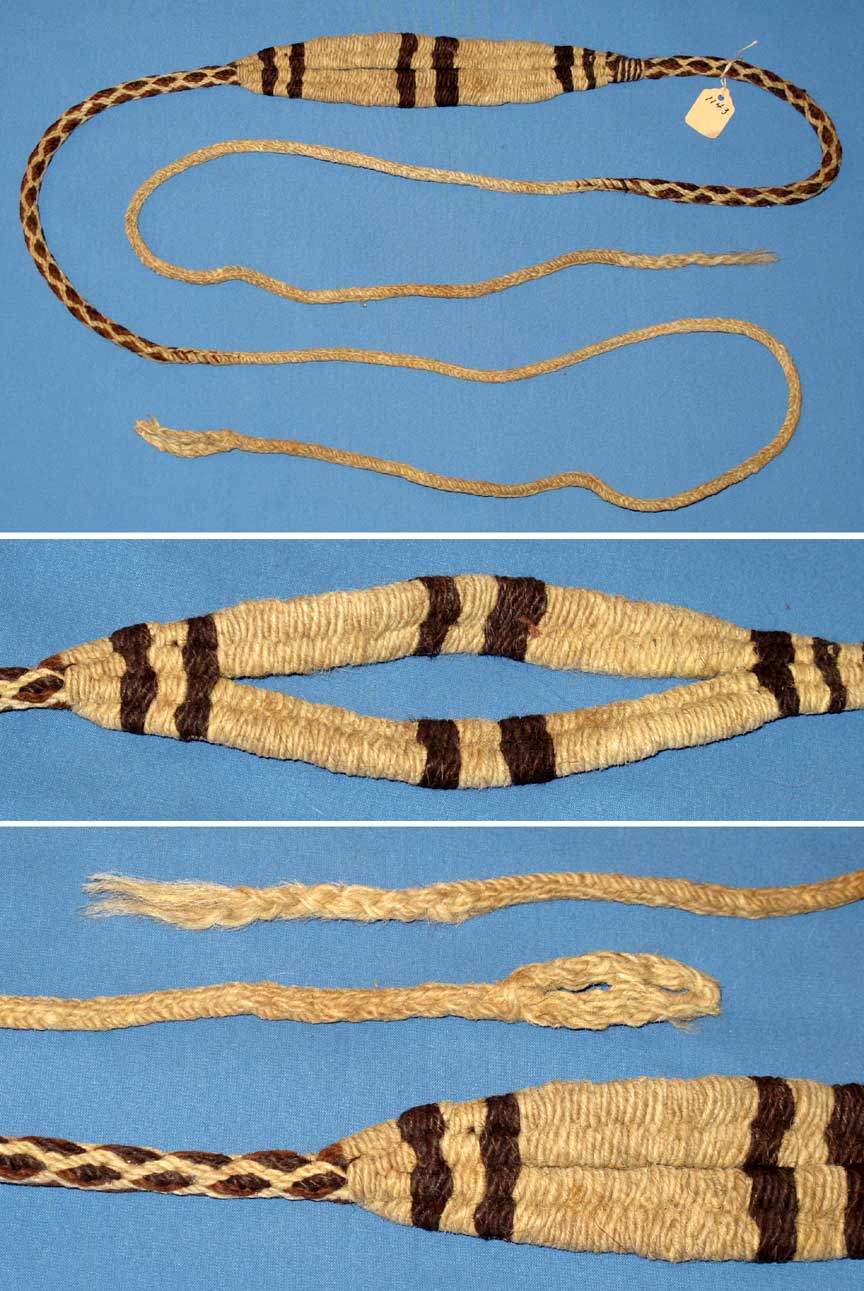Item TB506
|
The current price is listed on the South American Artifacts link. Instructions for ordering can be found on the How to Order web page. Please read the legal notice regarding the sale of pre-Columbian artifacts. |
|
This item is a Pre-Columbian Nazca sling made out of woven camelid fibres. Most of the 18 cm bicolor pouch is split and each side has a 24 cm lead that transitions into fully intact lines. One end has a braided finger loop. The other end has a tuft of hair to make the release quiet. This sling is complete and in very nice condition. No obvious breaks or major wear. There is some wear on the finger release from use, but it is fully intact. The lines are in very good condition with no breaks. This is a very practical device, not ceremonial and fully functional. This sling was one of about 90 slings and tumps that was purchased by the Foliophiles Collection from the Parke Bernet Auction House (New York City) in 1965. The Parke Bernet Auction House was purchased by Sotheby's Auctions a few years later. The Foliophiles Collection brought the collection to The Textile Museum in Washington, D.C. to be authenticated. Two slings were given to the museum. Thirty slings and tumps were sold between 1965 and 2002. I purchased the remainder of the collection when the owner of the Foliophiles Collection retired. I have been slowly selling the remainder of the collection to my customers. This sling can be legally marketed in the USA, but it cannot be exported. A copy of the letter proving that the date of acquisition was before the 1972 import ban will be provided to the purchaser upon receipt of payment. You should retain a copy of the letter as proof that your sling is legal to own in the USA.
The Nazca ( or Nasca ) people of Southern Peru are the ancestors of the famous Incas. The Nazca lived in a system of valleys in what is currently Southern Peru between 200 BC and 600 AD. The Nazcas developed from the earlier Paracas culture. Since the Nazca were a coastal people who depended on the sea for their livelihood, archaeologists are fortunate that the Nazca portrayed aspects of their everyday lives in and on their pottery and textiles. Much of their art was influenced by the Moche culture. The motifs generally found on these artifacts are those of animals and plants used and seen by the ancient people. These include sea birds, hummingbirds, whales, sharks, fish, snakes, seeds, flowers, and cacti. Nazca religious art portrays a wide range of fantastic half-human, half-animal creatures, thought to be symbols of the most fearsome creatures inhabiting the earth, sky, and water. Also, more gruesomely, the Nazca portrayed disembodied heads, presumed to be trophy heads, on their pottery. The Nazca are most famous for their geoglyphs, line art located in the Nazca Desert, a high and arid plateau that stretches between the towns of Nazca and Palpa on the pampa (a large flat area of southern Peru). The Nazca plain is virtually unique for its ability to preserve the markings upon it, due to the combination of the climate (one of the driest on Earth, with only twenty minutes of rainfall per year) and the flat, stony ground which minimizes the effects of the wind at ground level. The Nazca are well known for their textiles. They began using massive quantities of llama and alpaca wool a thousand years before the north coast cultures began to esteem the camelid wool. The source of the wool is believed to be from the Ayacucho region. The motifs that appeared on the pottery appeared earlier in the textiles. Textiles may have been as important to other cultures in the region as to the Nazca, but the desert has preserved the textiles of both the Nazca and Paracas cultures and comprise most of what is known about early textiles in the region. |

How to Order | Back to: South American Artifacts | Collectable Artifacts | Historical Artifact Prices | contact: Ted Bailey